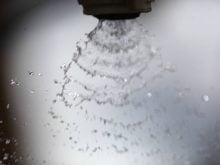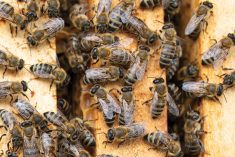“Until I crunched the numbers, I never thought we had that much.”
– RHEAL LAFRENIERE, MAFRI
Manitoba beekeepers had a surprisingly good honey crop this summer, despite unfavourable weather conditions.
A preliminary Manitoba Agriculture, Food and Rural Initiatives survey shows producers averaged 177 pounds of honey per colony, above the long-term provincial average of 165 pounds.
It’s an about-face from the situation in August, when cool weather and a delayed bloom threatened to depress honey yields significantly.
Rheal Lafreniere, Manitoba’s provincial apiarist, said he expected yields to average 150 pounds per colony but was pleasantly surprised when survey results started coming in.
Read Also

Mazergroup’s Bob Mazer dies
Mazergroup’s Bob Mazer, who helped grow his family’s company into a string of farm equipment dealerships and the main dealer for New Holland machinery in Saskatchewan and Manitoba, died July 6 from cancer.
“Until I crunched the numbers and saw 177, I never thought we had that much.”
Lafreniere warned the results are preliminary and final figures could be lower. The majority of responses so far are from western Manitoba, which saw higher honey yields than in the east, where cool, damp conditions prevailed throughout much of the growing season.
Final survey results are expected by mid-November.
Warm, dry weather in September made the difference between an above-average crop and a below-average one. Lafreniere said alfalfa crops were still blooming in September and the honey flow continued for at least three weeks longer than usual.
Adverse weather hurt honey production elsewhere in the country this summer. Drought depressed yields in British Columbia and Alberta, while cool, wet weather lowered production in Eastern Canada.
But Manitoba experienced enough breaks in the weather to boost output, Lafreniere said.
The province’s 77,000 honey colonies are expected to produce just over 13.6 million pounds of honey this year.
Another good sign is that bees are entering winter in much better condition than expected. The extended honey flow this fall means bees have ample food supplies in store for overwintering, he said.
Also positive are honey prices, currently fluctuating between $1.60 and $1.70 a pound. The average cost of production for a Manitoba honey producer is $1.25 a pound. This means most beekeepers should be profitable this year, said Lafreniere.
But Manitoba is still playing catch-up from below-average production in 2007 and 2008, plus a severe and as-yet unexplained loss of honeybees last winter, he said.
Manitoba producers lost 32 per cent of their bee colonies, far higher than the 20 per cent normal overwinter loss rate. Nationally, bee losses were even higher at nearly 35 per cent.
Some producers failed to make up losses from last winter and ended up running fewer bee colonies this year. Manitoba had 80,000 colonies in 2008, but some were not production colonies.
This was supposed to be a recovery year for Manitoba producers. But bee numbers are still not back to where they were five years ago, Lafreniere said.
“Every year we seem to be shrinking our industry.”
The industry’s main challenge right now is to learn the reason for the high die-off rate, not just in Manitoba but worldwide.
Much has been made of a mysterious syndrome called Colony Collapse Disorder, in which adult bees go missing from hives for no apparent reason. But most scientists now believe bee losses are due to a combination of factors and CCD is only one of them.
The varroa mite, a parasitic insect endemic in honey colonies, is seen as a big reason for bee losses, especially since the mite is becoming resistant to chemical controls.
Lafreniere said Manitoba producers recently received emergency approval to use Apivar, a new non-resistant product, for varroa control.
He urged producers to monitor their colonies carefully for [email protected]


















